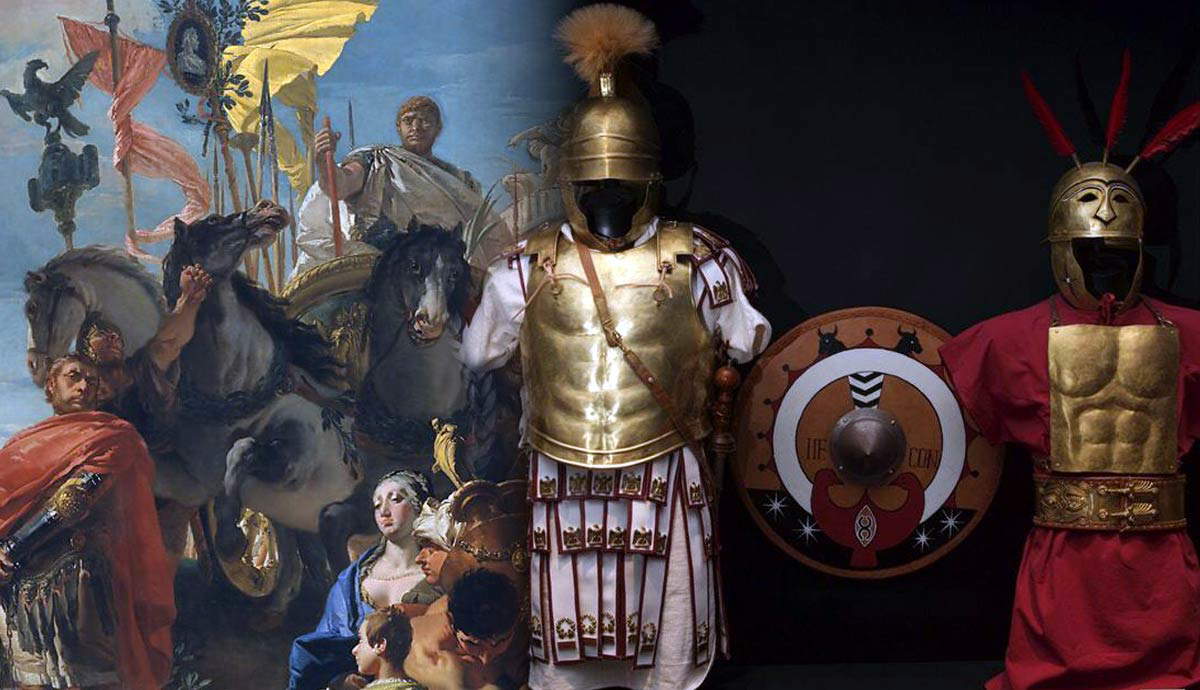
www.thecollector.com
Evolution of the Roman Army (From the Republic to the Empire’s Fall)
Rome was built with the edge of the sword. They carved out their empire with a ruthless military machine that laid low all before them. Perhaps the greatest reason for Roman military success was the willingness to innovate. The army was constantly evolving its fighting forces as it expanded its borders or defended itself against a rising tide of foes. From the aggressive phalanx in central Italy to the border forts on the edge of the frontier, Rome’s legions were in a constant state of evolution.
Roman Army: Mythic Past and Early Republic
Capitoline She-Wolf, Rome, c. 5th century BCE. Source: Musei Capitolini, Rome
From its beginnings in the mythic past, Rome was at war. Rome’s legendary founder, Romulus, waged constant battles against neighboring city-states in an effort to expand Roman territory and influence. This era is shrouded in mystery, with fact and myth inseparably mixed. From what we can glean from the early sources, the military of the early kingdom seemed to be ad hoc militias, farmers, and tradesmen putting down their tools and picking up spears to fight in limited campaigns against nearby enemies.
The first real attempt at organizing the Roman military was during the reign of King Servius Tullius. The army was first organized into a cohesive unit, which was divided according to wealth and social class, as well as what equipment the soldier could afford. They fought as hoplites, no doubt inspired by Greek colonies in southern Italy. These infantrymen were equipped with bronze or linen armor breastplates, face covering helmets, and a circular shield called a hoplon, which gave the soldier their name. Their main weapon was a spear, and the hoplites fought in a dense block of men called a phalanx. With their shields overlapping, the phalanx was a solid wall of steel, bronze, and flesh that attempted to push aside the enemy.
The Romans also used other troops, such as skirmishers who tried to break up the enemy phalanx before the main body closed in. Cavalry was also limited in number and reserved for the richest citizens who could afford to own a horse.
The Birth of the Legions
Reproduction of Early Republican Armor. Source: Museo Storico-Didattico del Legionario Romano
Early in the 3rd century BCE, the Roman Republic was reorganized into a new fighting force, with the first mention of a unit called the Legion, or legio. Meaning “levy,” it originally meant all of Rome’s citizens under arms, but eventually evolved into a unit of around 4,200 infantry men and 300 cavalry. The legion was made up of a number of classifications of soldiers based on age and property ownership. Equipment was provided by each soldier from their own finances, so there was a wide variety of types and quality of gear found in any army of the mid-Republic. Cavalry was drawn from the wealthiest soldiers who could afford a horse. They were equipped with a long spear, sword, round shield, helmet, and armor. They rode without stirrups, as these had not been invented yet and, in all likelihood, charged the enemy at a trot. The bulk of Rome’s forces, however, were infantry.
The first ranks of foot soldiers were made up of the youngest and poorest of the men in the army called velites. These soldiers were equipped with a bundle of javelins, a sword, and a small round shield. They also wore wolf pelts as a way for commanders to easily identify them in the confusion of battle, which may also have had a totemic or religious significance. The velites acted as skirmishers, advancing in front of the main body of troops, throwing their javelins to disrupt the enemy before falling back.
The first main line of battle was made up of men in their late teens to early twenties called the hastati, which translates to “spearmen,” though they did not use this weapon. The name was possibly a holdover from an earlier time. They were equipped with a pair of javelins called pilum, which had long iron shafts attached to a wooden handle. When thrown, the pilum would pierce the enemy’s shield easily, hitting the man holding it. Even if it didn’t cause a serious injury, the iron shaft would bend, fixing it in place, making the shield cumbersome to use and the pilum impossible to throw back.
Bent Pila heads, pugio dagger, gladius blade, and sheaths, Roman, c. 1st century BCE. Source: British Museum
They were also equipped with a short stabbing sword called the gladius, which was used in close quarters. For defense, the hastati wore a wide array of armor, from mail made from interlocking metal rings to scale armor to bronze plates strapped to the chest with leather strips. They were also protected by conical bronze helmets.
The second line of troops consisted of the princeps or “leaders,” though they were not the first ranks, and again was probably a name from an earlier time in Rome’s history. They were similarly equipped to the hastati, but were made up of older men in their late twenties and thirties, the prime of life, who had accrued the necessary wealth for better equipment than their younger counterparts. In battle, they were the principal offensive arm of the army. After the hastati ground down their enemy, they advanced and delivered the finishing blow to the exhausted enemy.
The third and final line was manned by the triarii, or “thirds.” These were the oldest and most experienced soldiers in Rome’s army and weren’t expected to see combat, being wealthy land owners, politicians, and others deemed too valuable to risk in the front lines. Instead, they acted as a reserve, only being deployed in times of crisis, their experience hopefully bringing order to a chaotic situation. Unlike their compatriots, they were equipped with long spears instead of pilum.
Replica of Roman Armor and Weapons circa 400 BCE. Source: University of Auckland
All of these ranks were divided into centuries of sixty men each, and the hastati and princeps were grouped into pairs of centuries called a maniple, or “handful.” These were tactically flexible units that were easier to maneuver and deploy than the cumbersome phalanx. This time period also saw the origins of dedicated officers, the centurion to lead them, the optio as second in command, and the signifer who carried the century’s standard. These positions carried over into later evolution of the army.
There were a few modifications over the centuries, but this basic method saw Rome through the existential crisis of the Punic Wars and the conquest of much of the western Mediterranean. By the end of the 2nd century BCE, it became apparent that Rome’s reliance on part-time militiamen was no longer adequate for the needs of the state. The famous Roman general Gaius Marius (c. 157-86 BCE) instituted the so-called Marian reforms, completely overhauling the Roman Army.
The Legions Become Professional
The Triumph of Marius, by Giovanni Battista Tiepolo, 1729. Source: Metropolitan Museum of Art
Marius’s most important policy was removing the property requirement to serve. Any Roman could join, serving 20 and later 25-year terms of service paid for by the state. To ensure uniformity, the recruits no longer had to provide their own equipment but had their weapons and armor subsidized at state expense. The militia force raised for a specific campaign was replaced by a standing professional army whose only occupation was warfare.
The maniple system was also overhauled. Centuries of 80 men would be placed in groups of six, called a cohort, and ten cohorts would form a legion. The class and age distinction made in the earlier army was done away with, with men grouped in each unit without regard to wealth or experience. Like their predecessors, they would be primarily heavy infantry and were equipped with a large oblong and later rectangular shield called a scutum, an open faced helmet, pilum, gladius, pugio, a type of dagger, and armor, most often in the form of mail, but also lorica segmentata, made from overlapping bands of steel.
Glass Relief Fragment First Century ACE. Source: Metropolitan Museum of Art
Each legion also contained specialist troops, such as artillery crews who were trained to use various types of ballistae and catapults designed to hurl stones or large bolts long distances. Cavalry were armed with lances, javelins, large shields, mail armor, and the spatha, a long, straight bladed sword. Cavalrymen were drawn from citizen recruits or foreigners who made up the auxilia. The auxilia were non-Romans who served in specialist roles, such as cavalry or archers, and would gain their citizenship after their term of service. This basic structure served Rome from the tumultuous late Republic to the farthest extent of the Empire, from the shores of the British Isles to the sands of the Middle East. But Rome’s military would undergo one final major change before its fall.
The Army at the End of the Roman Empire
Roman Ridge Parade Helmet, c. 4th century CE. Source: Museum of Vojvodina, Serbia
In the waning days of the Empire, the once mighty legions were but a shadow of their former selves. The most drastic change was the operational role of the army, which switched from conquering foreign lands to maintaining the border, and later holding back the inevitable tide of barbarian invasions. In light of this defensive posture, the legions were reorganized broadly into the comitatenses and the limitanei.
The limitanei were stationary border troops, who manned garrisons at the extent of Roman boundaries. They had multiple roles, including customs duties, border security, and driving off small-scale raids from the ever emboldened barbarians outside of the Empire. These were comparatively poorly paid troops who were not expected to be able to withstand a major invasion.
The comitatenses made up the field army and, unlike their limitanei counterparts, did not have a fixed base of operations. They moved from crisis area to crisis area as needed. They were more highly paid and of a higher status as well. Instead of conquering new lands, the army fought defensively, the limitanei throwing back small scale raids, and providing early warning of larger incursions. Should they not be able to withstand an invasion, they would send word, and the comitatenses would arrive in force to drive off the enemy that was already weakened by the limitanei and their forts. Through this strategy of defense in depth, the Romans of Late Antiquity were able to hold their borders with fewer troops, forestalling the end of the empire.
The equipment of soldiers of the late empire changed significantly from their heyday. After over a century of civil wars, foreign invasions, and economic turmoil, Rome was no longer able to provide the same quality of weapons and armor it had in previous centuries. The legionnaires still utilized large, oblong shields and mail armor, but the helmet, once made from a single piece of metal, was now made in the Intercisa pattern, using two separate plates joined together by a metal band, as well as spangenhelms, which were made from three or more plates forged together, which is much cheaper and easier to produce. There is also some evidence for the appearance of nasal guards, which had not been utilized before in Roman helmets.
Vercingetorix Throws Down his Arms at the Feet of Julius Caesar, by Lionel Royer, 1899. Source: Wikimedia Commons
The pilum was still used, but more conventional javelins and plumbata, weighted lead darts, were becoming more common. These darts were lighter, could be thrown further, and could be clipped to the back of a shield for ease of carrying. The gladius, the short stabbing sword that carved out Rome’s empire, was replaced with the spatha, a longer-bladed weapon once used by cavalry troops, as were spears.
Even with these reforms, it was not enough to stem the inexorable decay of the Empire, and Rome would crumble under tides of barbarian invasions. With the fall of the Western Roman Empire, the Roman war machine, whose origins stretched to the mythic past, whose mighty legions laid low all who opposed them, now fell silent. An echo of their might lived on in the Eastern Roman Empire, which would rule for another thousand years.















